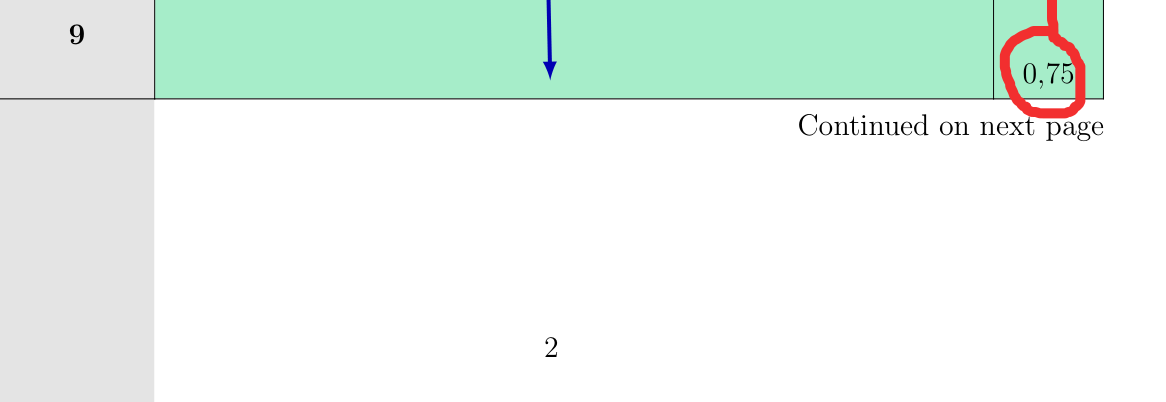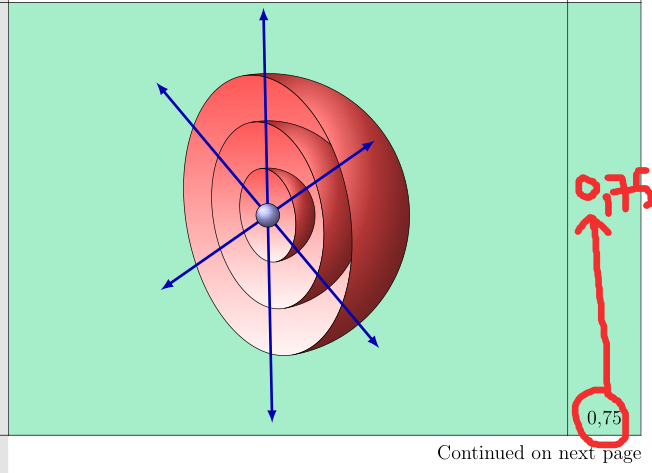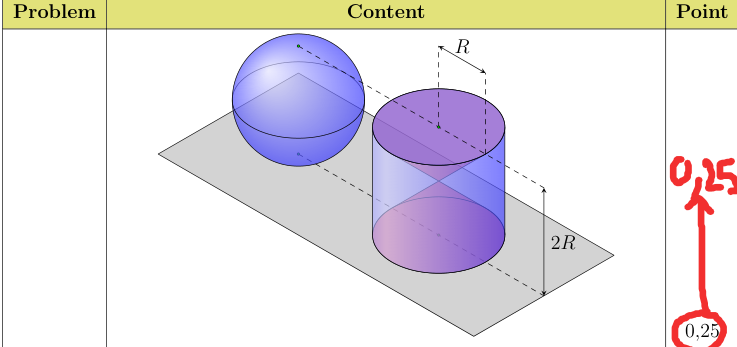I have this table
```
\documentclass[12pt]{article}
\usepackage{tabularray}
\usepackage[utf8]{vietnam}
\UseTblrLibrary{diagbox}
\UseTblrLibrary{varwidth}
\UseTblrLibrary{booktabs}
\UseTblrLibrary{counter}
\usepackage{enumitem}
\usepackage{ninecolors}
\UseTblrLibrary{amsmath}
%\usepackage{amsmath}
\usepackage{amssymb}
\usepackage{siunitx}
\sisetup{output-decimal-marker={,}}
\UseTblrLibrary{siunitx}
\usepackage{tikz}
\usetikzlibrary{3d} % 'canvas is...' options
\usetikzlibrary{perspective} % isometric view
% isometric axes
\pgfmathsetmacro\xx{1/sqrt(2)}
\pgfmathsetmacro\xy{1/sqrt(6)}
\pgfmathsetmacro\zz{sqrt(2/3)}
\def\r{2} % radius
\pgfdeclareradialshading{rblue}{\pgfpoint{-0.4cm}{0.4cm}}
{% shading, sphere
color(0cm)=(blue!10);
color(1cm)=(blue!80)
}
\pgfdeclarehorizontalshading{hblue}{100pt}
{% shading, cylinder
color(0pt)=(blue!80);
color(30pt)=(blue!20);
color(100pt)=(blue!100)
}
% styles
\tikzset%
{%
isometric/.style={x={(-\xx cm,-\xy cm)},y={(\xx cm,-\xy cm)},z={(0cm,\zz cm)}},
plane/.style={fill=gray,fill opacity=0.4},
sphere/.style={shading=rblue,fill opacity=0.7},
cylinder surface/.style={shading=hblue,fill opacity=0.7},
cylinder base/.style={fill=blue!50,fill opacity=0.7},
cone/.style={fill=red,fill opacity=0.5}
}
\usepackage[paperwidth=19cm, paperheight=26.5cm, left=1.7cm,right=1.7cm,top=1.8cm,bottom=1.7cm]{geometry}
\DefTblrTemplate{contfoot-text}{normal}{Continued on next page}
\SetTblrTemplate{contfoot-text}{normal}
\DefTblrTemplate{conthead-text}{normal}{(Continued)}
\SetTblrTemplate{conthead-text}{normal}
\SetTblrTemplate{conthead-text}{normal}
\newcounter{mycnta}
\newcommand{\mycnta}{\stepcounter{mycnta}\arabic{mycnta}}
\newcommand{\startproblem}[1]{
\SetCell[r=#1]{m}\SetRow{bg=teal9}\SetCell{bg=gray9}\mycnta
}
\begin{document}
\begin{longtblr}[
expand=\startproblem,
caption={Some text}]{
colspec = {Q[c,gray9]X[l,valign=m]Q[c]},
rowhead = 1,
vlines,
hlines,
row{1}={yellow9,font=\bfseries},
cell{1}{2-3}={halign=c},
column{1}={font=\bfseries},
}
Problem & Content & Point \\
\startproblem{5} & Solve the equation $ x^2 - 5x + 6 = 0 $ & \num{1.00} \\
& $ \Delta =(-5)^2 - 4 \cdot 1 \cdot 6 = 1$, & \num{0.25} \\
& $ x = \dfrac{-(-5) -1}{2} = 2$. & \num{0.25} \\
& $ x = \dfrac{-(-5) + 1}{2} = 3$ & \num{0.25} \\
& The given equation has two solutions $x=2$ and $x = 3$. & \num{0.25} \\
\startproblem{4} & Find the derivaty of the function $ y = \dfrac{2x+1}{x-2} $ $ y = \dfrac{2x+1}{x-2} $ $ y = \dfrac{2x+1}{x-2} $ $ y = \dfrac{2x+1}{x-2} $ $ y = \dfrac{2x+1}{x-2} $ $ y = \dfrac{2x+1}{x-2} $& \num{0.75} \\
& $ y' = \dfrac{(2x+1)'(x-2)-(2x+1)(x-2)'}{(x-2)^2}$. & \num{0.25} \\
& $ y'=\dfrac{2(x-2) -(2x+1)}{(x-2)^2}$. & \num{0.25} \\
& $y'=-\dfrac{5}{(x-2)^2}$. & \num{0,25} \\
\startproblem{3} & Is this $ x^2 + 3x +4 >0$ true or fail? why? & \num{0.75} \\
& $ x^2 + 3x +4 >0$ true. & \num{0.25} \\
& $ x^2 + 3x +4 $ have $ \Delta = -7<0 $ and coefficient of $ x^2 $ is $ 1 >0$. & \num{0.50}
\\
\startproblem{5} & Solve the equation $ x^2 - 5x + 6 = 0 $ & \num{1.00} \\
& $ \Delta =(-5)^2 - 4 \cdot 1 \cdot 6 = 1$, & \num{0.25} \\
& $ x = \dfrac{-(-5) -1}{2} = 2$. & \num{0.25} \\
& $ x = \dfrac{-(-5) + 1}{2} = 3$ & \num{0.25} \\
& The given equation has two solutions $x=2$ and $x = 3$. & \num{0.25} \\
\startproblem{4} & Find the derivaty of the function $ y = \dfrac{2x+1}{x-2} $ & \num{0.75} \\
& $ y' = \dfrac{(2x+1)'(x-2)-(2x+1)(x-2)'}{(x-2)^2}$. & \num{0.25} \\
& $ y'=\dfrac{2(x-2) -(2x+1)}{(x-2)^2}$. & \num{0.25} \\
& $y'=-\dfrac{5}{(x-2)^2}$. & \num{0,25} \\
\startproblem{3} & Is this $ x^2 + 3x +4 >0$ true or fail? why? & \num{0.75} \\
& $ x^2 + 3x +4 >0$ true. & \num{0.25} \\
& $ x^2 + 3x +4 $ have $ \Delta = -7<0 $ and coefficient of $ x^2 $ is $ 1 >0$. & \num{0.50}
\\
\startproblem{5} & Solve the equation $ x^2 - 5x + 6 = 0 $ & \num{1.00} \\
& $ \Delta =(-5)^2 - 4 \cdot 1 \cdot 6 = 1$, & \num{0.25} \\
& $ x = \dfrac{-(-5) -1}{2} = 2$. & \num{0.25} \\
& $ x = \dfrac{-(-5) + 1}{2} = 3$ & \num{0.25} \\
& The given equation has two solutions $x=2$ and $x = 3$. & \num{0.25} \\
\startproblem{4} & Find the derivaty of the function $ y = \dfrac{2x+1}{x-2} $ & \num{0.75} \\
& $ y' = \dfrac{(2x+1)'(x-2)-(2x+1)(x-2)'}{(x-2)^2}$. & \num{0.25} \\
& $ y'=\dfrac{2(x-2) -(2x+1)}{(x-2)^2}$. & \num{0.25} \\
& $y'=-\dfrac{5}{(x-2)^2}$. & \num{0,25} \\
\startproblem{3} &\SetCell{c}
\begin{tikzpicture}[isometric view,rotate=-20]
% sphere, inner
\foreach\i in {3,2,1}
\draw[canvas is yz plane at x=0,top color=red!70] (0,0) circle (\i);
% sphere, outer
\foreach\i in {1,2,3}
\draw[shading=ball,ball color=red!70] (120:\i cm) arc (120:-60:\i cm)
{[canvas is yz plane at x=0] arc (225: 45:\i)};
% rays
\foreach\i in {0,60,120}
\draw[canvas is yz plane at x=0,blue!70!black,ultra thick,latex-latex]
(\i:4.5) -- (\i+180:4.5);
\draw[shading=ball,ball color=blue!30] (0,0) circle (0.25cm);
\end{tikzpicture} & \num{0.75} \\
&
\SetCell{c} \begin{tikzpicture}[isometric,line cap=round,line join=round,scale=.7]
% plane and points
\draw[plane] (-3,-9,-2) -- (-3,4.5,-2) -- (3,4.5,-2) -- (3,-9,-2) -- cycle;
\draw[dashed] (0,-6,-2) -- (0,4.5,-2);
\foreach\y in {-6,0}
\draw[fill=green] (0,\y,-2) circle (1pt);
% sphere
\draw (0,-6,0) ++ (315:2) arc (315:135:2);
\draw[sphere] (0,-6,0) circle (2cm);
\draw (0,-6,0) ++ (-45:2) arc (-45:135:2);
% cone
\draw[cone] (2,0,2) arc (0:90:\r) -- (0,-2,-2) arc (-90:180:2) -- cycle;
\draw[cone] (0,0,2) circle (2);
% cylinder
\draw (0,0,-2) ++ (315:2) arc (315:135:2);
\draw[cylinder surface] (0,0,-2) ++ (-45:2) arc (-45:135:2) --++ (0,0,4) arc (135:-45:2) -- cycle;
\draw[cylinder base] (0,0,2) circle (2);
% lines and points
\draw[dashed] (0,-6,2) -- (0,4.5,2);
\foreach\y in {0,2}
\draw[dashed] (0,\y,2) -- (0,\y,5);
\draw[stealth-stealth] (0,4.5,2) -- (0,4.5,-2) node [midway,right] {$2R$};
\draw[stealth-stealth] (0,0,5) -- (0,2,5) node [midway,above] {$R$};
\foreach\y in {-6,0}
\draw[fill=green] (0,\y,2) circle (1pt);
\end{tikzpicture} & \num{0.25} \\
& $ x^2 + 3x +4 $ have $ \Delta = -7<0 $ and coefficient of $ x^2 $ is $ 1 >0$. & \num{0.50}\\
\startproblem{4} & Solve the equation
$(2 x+3)\cdot \sqrt{4 x+5}+(6 x+7) \cdot\sqrt{8 x+9}=2. $
& \num{0.75} \\
& $ y' = \dfrac{(2x+1)'(x-2)-(2x+1)(x-2)'}{(x-2)^2}$. & \num{0.25} \\
& $ y'=\dfrac{2(x-2) -(2x+1)}{(x-2)^2}$. & \num{0.25} \\
& $y'=-\dfrac{5}{(x-2)^2}$. & \num{0,25} \\
\end{longtblr}
\end{document}
```
I have some problems:
1. gray column


2. How can I use `\c=SetCell[m]` at the cells

There are two unrelated problems:
- you can use the `baseline` option to change the vertical alignment of the tikzpicture with respect to the surrounding text
- to avoid the merged cells to spill over the bottom of the page, you can use `\nopagebreak` to avoid page breaks in the rows which share a merged cell (might result in a lot of white space as you cells are very large)
```
\documentclass[12pt]{article}
\usepackage{tabularray}
\usepackage[utf8]{vietnam}
\UseTblrLibrary{diagbox}
\UseTblrLibrary{varwidth}
\UseTblrLibrary{booktabs}
\UseTblrLibrary{counter}
\usepackage{enumitem}
\usepackage{ninecolors}
\UseTblrLibrary{amsmath}
%\usepackage{amsmath}
\usepackage{amssymb}
\usepackage{siunitx}
\sisetup{output-decimal-marker={,}}
\UseTblrLibrary{siunitx}
\usepackage{tikz}
\usetikzlibrary{3d} % 'canvas is...' options
\usetikzlibrary{perspective} % isometric view
% isometric axes
\pgfmathsetmacro\xx{1/sqrt(2)}
\pgfmathsetmacro\xy{1/sqrt(6)}
\pgfmathsetmacro\zz{sqrt(2/3)}
\def\r{2} % radius
\pgfdeclareradialshading{rblue}{\pgfpoint{-0.4cm}{0.4cm}}
{% shading, sphere
color(0cm)=(blue!10);
color(1cm)=(blue!80)
}
\pgfdeclarehorizontalshading{hblue}{100pt}
{% shading, cylinder
color(0pt)=(blue!80);
color(30pt)=(blue!20);
color(100pt)=(blue!100)
}
% styles
\tikzset%
{%
isometric/.style={x={(-\xx cm,-\xy cm)},y={(\xx cm,-\xy cm)},z={(0cm,\zz cm)}},
plane/.style={fill=gray,fill opacity=0.4},
sphere/.style={shading=rblue,fill opacity=0.7},
cylinder surface/.style={shading=hblue,fill opacity=0.7},
cylinder base/.style={fill=blue!50,fill opacity=0.7},
cone/.style={fill=red,fill opacity=0.5}
}
\usepackage[paperwidth=19cm, paperheight=26.5cm, left=1.7cm,right=1.7cm,top=1.8cm,bottom=1.7cm]{geometry}
\DefTblrTemplate{contfoot-text}{normal}{Continued on next page}
\SetTblrTemplate{contfoot-text}{normal}
\DefTblrTemplate{conthead-text}{normal}{(Continued)}
\SetTblrTemplate{conthead-text}{normal}
\SetTblrTemplate{conthead-text}{normal}
\newcounter{mycnta}
\newcommand{\mycnta}{\stepcounter{mycnta}\arabic{mycnta}}
\newcommand{\startproblem}[1]{
\SetCell[r=#1]{m}\SetRow{bg=teal9}\SetCell{bg=gray9}\mycnta
}
\begin{document}
\begin{longtblr}[
expand=\startproblem,
caption={Some text}]{
colspec = {Q[c,gray9]X[l,valign=m]Q[c]},
rowhead = 1,
vlines,
hlines,
row{1}={yellow9,font=\bfseries},
cell{1}{2-3}={halign=c},
column{1}={font=\bfseries},
}
Problem & Content & Point \\
\startproblem{5} & Solve the equation $ x^2 - 5x + 6 = 0 $ & \num{1.00} \\
& $ \Delta =(-5)^2 - 4 \cdot 1 \cdot 6 = 1$, & \num{0.25} \\
& $ x = \dfrac{-(-5) -1}{2} = 2$. & \num{0.25} \\
& $ x = \dfrac{-(-5) + 1}{2} = 3$ & \num{0.25} \\
& The given equation has two solutions $x=2$ and $x = 3$. & \num{0.25} \\
\startproblem{4} & Find the derivaty of the function $ y = \dfrac{2x+1}{x-2} $ $ y = \dfrac{2x+1}{x-2} $ $ y = \dfrac{2x+1}{x-2} $ $ y = \dfrac{2x+1}{x-2} $ $ y = \dfrac{2x+1}{x-2} $ $ y = \dfrac{2x+1}{x-2} $& \num{0.75} \\
& $ y' = \dfrac{(2x+1)'(x-2)-(2x+1)(x-2)'}{(x-2)^2}$. & \num{0.25} \\
& $ y'=\dfrac{2(x-2) -(2x+1)}{(x-2)^2}$. & \num{0.25} \\
& $y'=-\dfrac{5}{(x-2)^2}$. & \num{0,25} \\
\startproblem{3} & Is this $ x^2 + 3x +4 >0$ true or fail? why? & \num{0.75} \\\nopagebreak
& $ x^2 + 3x +4 >0$ true. & \num{0.25} \\
& $ x^2 + 3x +4 $ have $ \Delta = -7<0 $ and coefficient of $ x^2 $ is $ 1 >0$. & \num{0.50}
\\
\startproblem{5} & Solve the equation $ x^2 - 5x + 6 = 0 $ & \num{1.00} \\
& $ \Delta =(-5)^2 - 4 \cdot 1 \cdot 6 = 1$, & \num{0.25} \\
& $ x = \dfrac{-(-5) -1}{2} = 2$. & \num{0.25} \\
& $ x = \dfrac{-(-5) + 1}{2} = 3$ & \num{0.25} \\
& The given equation has two solutions $x=2$ and $x = 3$. & \num{0.25} \\
\startproblem{4} & Find the derivaty of the function $ y = \dfrac{2x+1}{x-2} $ & \num{0.75} \\
& $ y' = \dfrac{(2x+1)'(x-2)-(2x+1)(x-2)'}{(x-2)^2}$. & \num{0.25} \\
& $ y'=\dfrac{2(x-2) -(2x+1)}{(x-2)^2}$. & \num{0.25} \\
& $y'=-\dfrac{5}{(x-2)^2}$. & \num{0,25} \\
\startproblem{3} & Is this $ x^2 + 3x +4 >0$ true or fail? why? & \num{0.75} \\\nopagebreak
& $ x^2 + 3x +4 >0$ true. & \num{0.25} \\
& $ x^2 + 3x +4 $ have $ \Delta = -7<0 $ and coefficient of $ x^2 $ is $ 1 >0$. & \num{0.50}
\\
\startproblem{5} & Solve the equation $ x^2 - 5x + 6 = 0 $ & \num{1.00} \\
& $ \Delta =(-5)^2 - 4 \cdot 1 \cdot 6 = 1$, & \num{0.25} \\
& $ x = \dfrac{-(-5) -1}{2} = 2$. & \num{0.25} \\
& $ x = \dfrac{-(-5) + 1}{2} = 3$ & \num{0.25} \\
& The given equation has two solutions $x=2$ and $x = 3$. & \num{0.25} \\
\startproblem{4} & Find the derivaty of the function $ y = \dfrac{2x+1}{x-2} $ & \num{0.75} \\
& $ y' = \dfrac{(2x+1)'(x-2)-(2x+1)(x-2)'}{(x-2)^2}$. & \num{0.25} \\
& $ y'=\dfrac{2(x-2) -(2x+1)}{(x-2)^2}$. & \num{0.25} \\
& $y'=-\dfrac{5}{(x-2)^2}$. & \num{0,25} \\
\startproblem{3} &\SetCell{c}
\begin{tikzpicture}[isometric view,rotate=-20,baseline]
% sphere, inner
\foreach\i in {3,2,1}
\draw[canvas is yz plane at x=0,top color=red!70] (0,0) circle (\i);
% sphere, outer
\foreach\i in {1,2,3}
\draw[shading=ball,ball color=red!70] (120:\i cm) arc (120:-60:\i cm)
{[canvas is yz plane at x=0] arc (225: 45:\i)};
% rays
\foreach\i in {0,60,120}
\draw[canvas is yz plane at x=0,blue!70!black,ultra thick,latex-latex]
(\i:4.5) -- (\i+180:4.5);
\draw[shading=ball,ball color=blue!30] (0,0) circle (0.25cm);
\end{tikzpicture} & \num{0.75} \\\nopagebreak
&
\SetCell{c} \begin{tikzpicture}[isometric,line cap=round,line join=round,scale=.7,baseline]
% plane and points
\draw[plane] (-3,-9,-2) -- (-3,4.5,-2) -- (3,4.5,-2) -- (3,-9,-2) -- cycle;
\draw[dashed] (0,-6,-2) -- (0,4.5,-2);
\foreach\y in {-6,0}
\draw[fill=green] (0,\y,-2) circle (1pt);
% sphere
\draw (0,-6,0) ++ (315:2) arc (315:135:2);
\draw[sphere] (0,-6,0) circle (2cm);
\draw (0,-6,0) ++ (-45:2) arc (-45:135:2);
% cone
\draw[cone] (2,0,2) arc (0:90:\r) -- (0,-2,-2) arc (-90:180:2) -- cycle;
\draw[cone] (0,0,2) circle (2);
% cylinder
\draw (0,0,-2) ++ (315:2) arc (315:135:2);
\draw[cylinder surface] (0,0,-2) ++ (-45:2) arc (-45:135:2) --++ (0,0,4) arc (135:-45:2) -- cycle;
\draw[cylinder base] (0,0,2) circle (2);
% lines and points
\draw[dashed] (0,-6,2) -- (0,4.5,2);
\foreach\y in {0,2}
\draw[dashed] (0,\y,2) -- (0,\y,5);
\draw[stealth-stealth] (0,4.5,2) -- (0,4.5,-2) node [midway,right] {$2R$};
\draw[stealth-stealth] (0,0,5) -- (0,2,5) node [midway,above] {$R$};
\foreach\y in {-6,0}
\draw[fill=green] (0,\y,2) circle (1pt);
\end{tikzpicture} & \num{0.25} \\
& $ x^2 + 3x +4 $ have $ \Delta = -7<0 $ and coefficient of $ x^2 $ is $ 1 >0$. & \num{0.50}\\
\startproblem{4} & Solve the equation
$(2 x+3)\cdot \sqrt{4 x+5}+(6 x+7) \cdot\sqrt{8 x+9}=2. $
& \num{0.75} \\
& $ y' = \dfrac{(2x+1)'(x-2)-(2x+1)(x-2)'}{(x-2)^2}$. & \num{0.25} \\
& $ y'=\dfrac{2(x-2) -(2x+1)}{(x-2)^2}$. & \num{0.25} \\
& $y'=-\dfrac{5}{(x-2)^2}$. & \num{0,25} \\
\end{longtblr}
\end{document}
```
